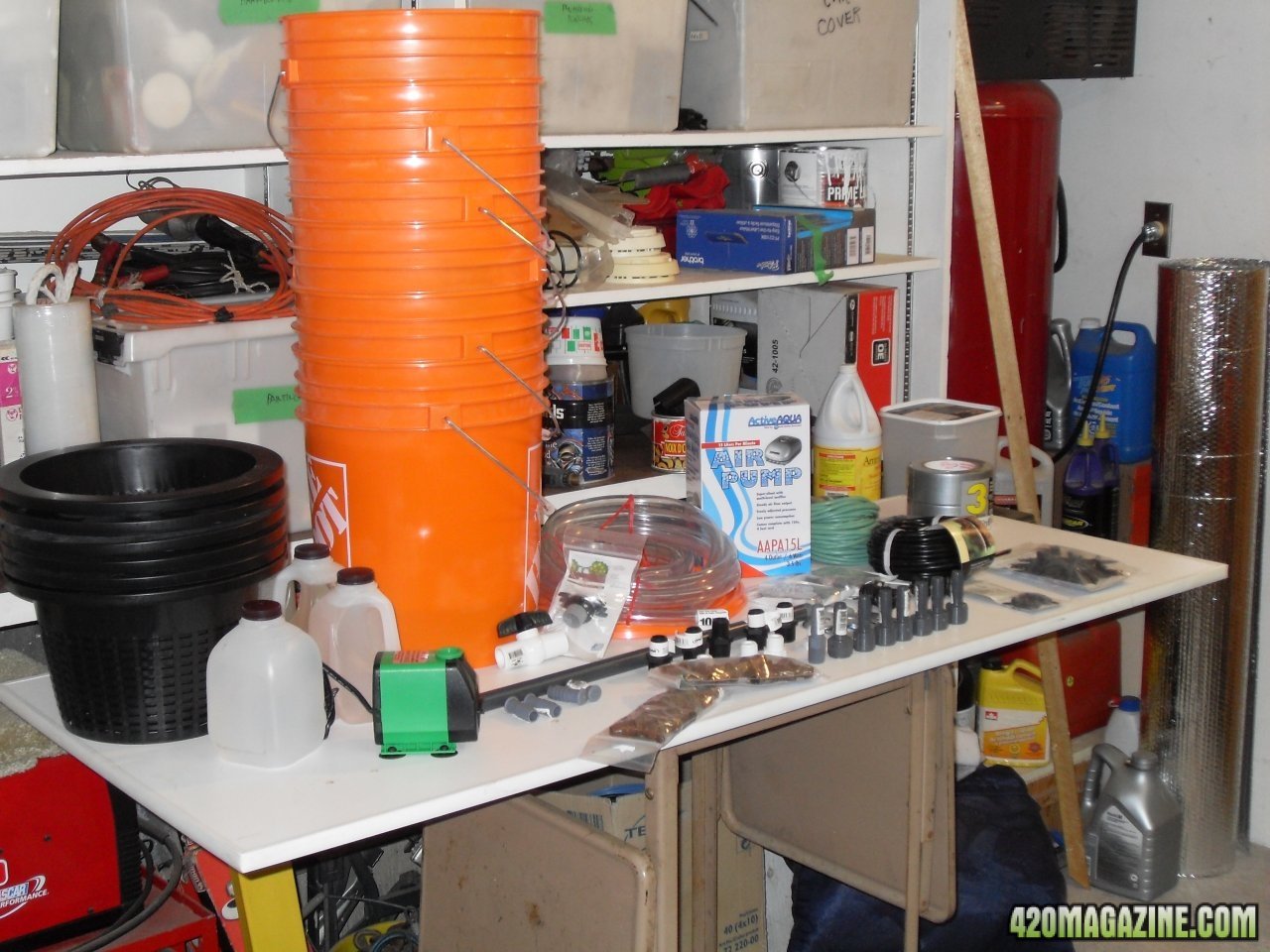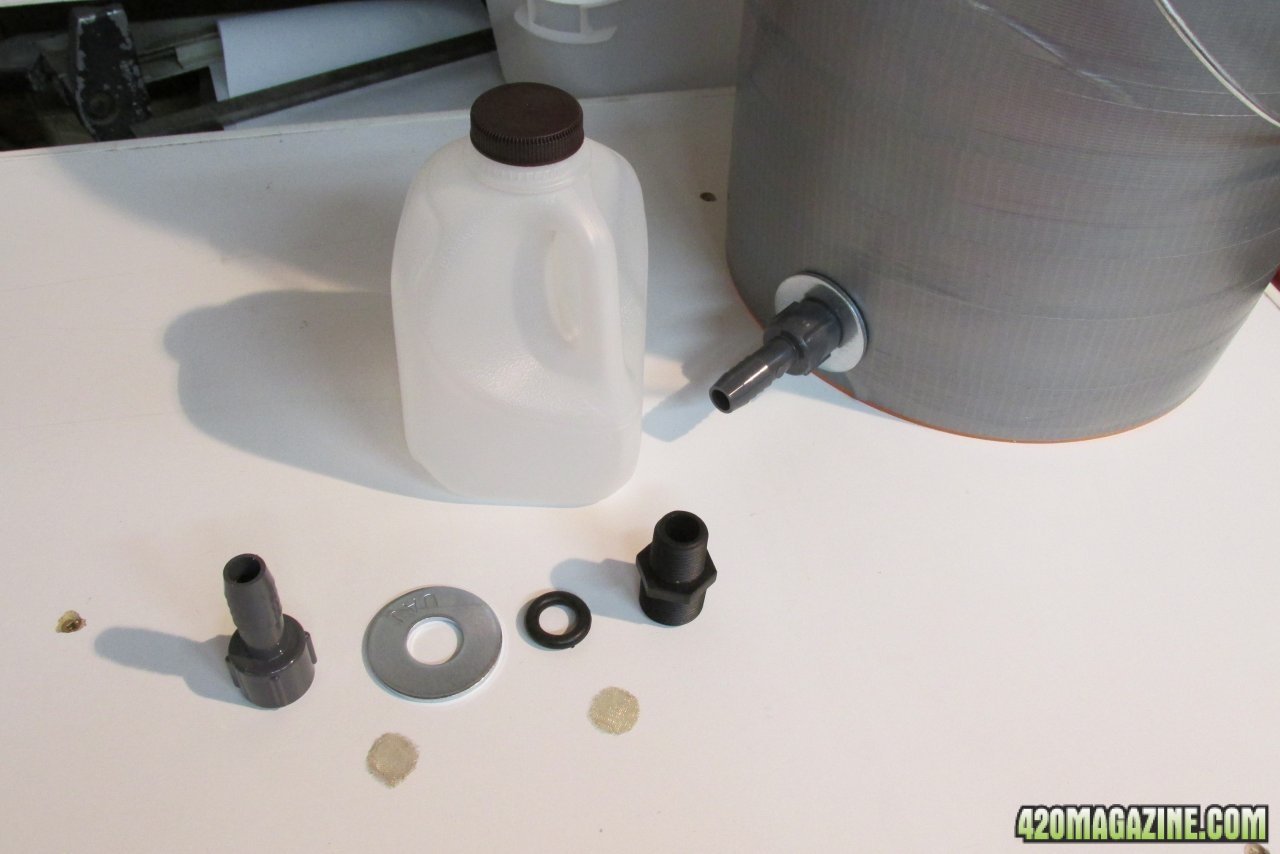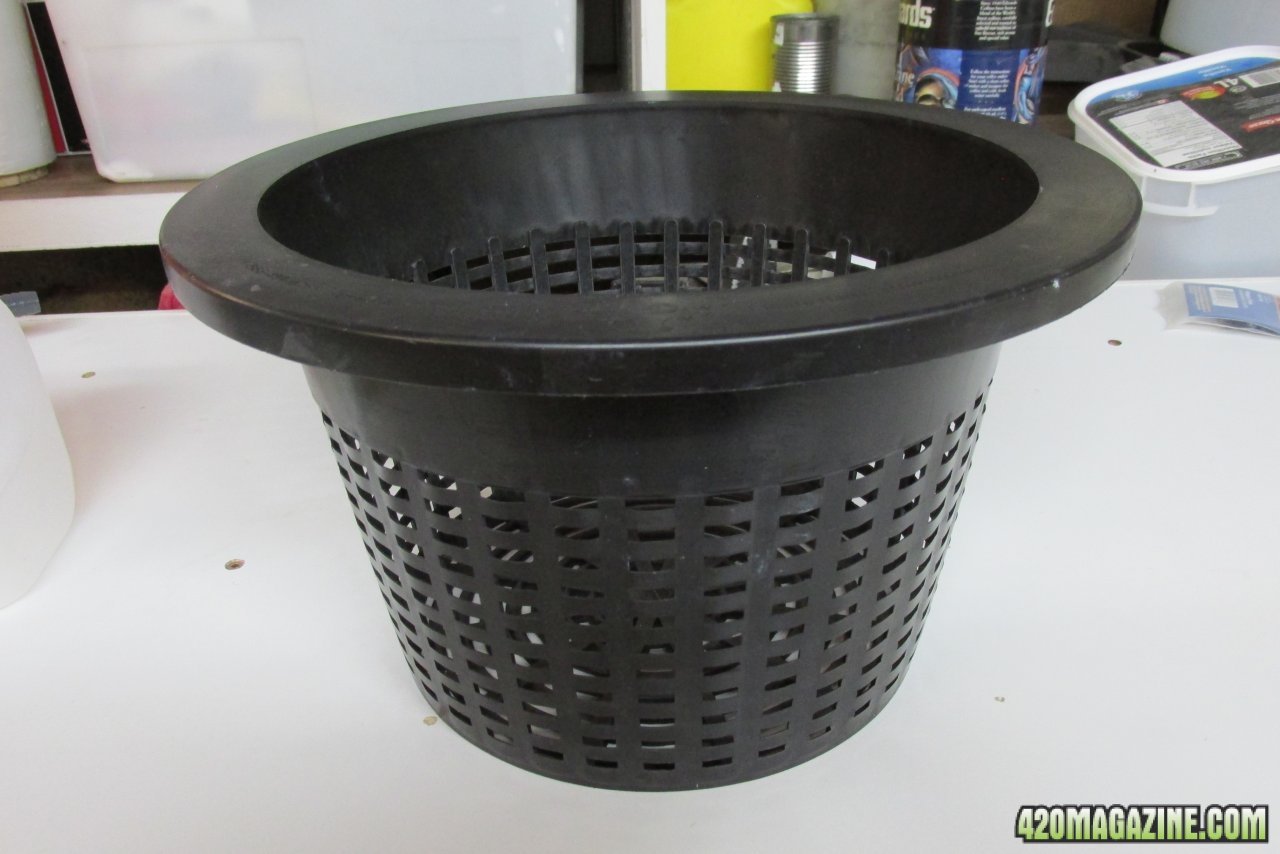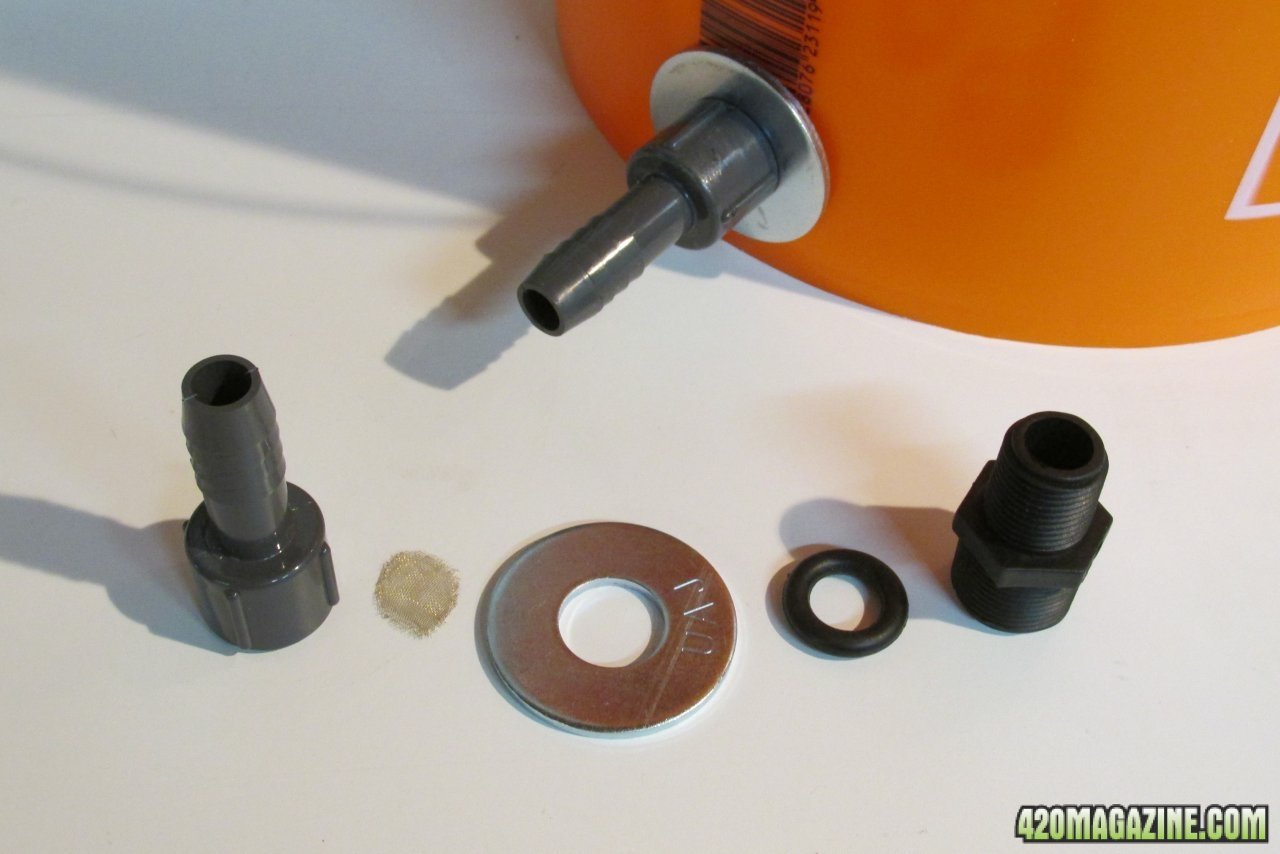we got a pile of stuff here

this is a dirt - er water simple rdwc system that you can piece together wherever you live. it is built to be expandable from one or two bucket sites, up to six or more, depending on pump size and distribution manifold. it is a very old design, and has been copied by most hydro suppliers in one form or another, over and over again.
this build will focus on the most basic set up, and will use a four bucket system for an example, to keep things nice and legal for the new norms being set in canada. the great thing about this system is it is infinitely adaptable and customizable once you understand the basic system. sites can be added or subtracted, extra reservoirs or chillers piped in, and it can be adapted to different spaces. it does use up space tho, and rdwc is not for everyone, newer techniques are replacing this style of hydro more and more.
this is an easy way to do it if you like doing stuff yourself and wanna give it a try.
first a word on cost.
hydro shop systems are coming down rapidly in price as attitudes change. it may not be worth it $$ wise to even build this system for some people if an off the shelf system works for them. i don't really keep track of the cost as some of this stuff i generally have on hand, but it costs about $200 cdn to piece this together. it can be done for less i'm sure with a little judicious shopping. the good news is the cost to make this stuff has gone down with the availabilty of new home irrigation systems, and their hardware.
if still on board here we go. so whatcha gonna need .....
the bucket site parts list :
each bucket site requires

1 - 5 gallon bucket. standard hydro shop or hardware supply store stuff
1 - 1/2 " pvc female threaded / barbed fitting. very standard fitting
1 - big ass washer. 7/16" inner diameter. pretty standard washer. fits over the skinny end of the black fitting in the pic
1 - thick rubber garden hose washer. you can get expensive o-rings, but the garden hose washer works the best for pennies
1 - 1/2" threaded to 3/4" threaded union. home irrigation part from a hardware store
2 - large brass hash pipe screens. you can use faucet screens but these work better
1 - 1L empty milk or yummy chocolate milk container. cleaned well and aired out
1 - net pot basket. hydro shop or amazon. mine are the largest, do that or one size smaller
way too big net pot gratuitous photo

you'll need everything here for each bucket site. 4 x each of the above for the example build. completed bucket in the background above. don't mind the duct tape . we'll chat lol . of course you're gonna need more but we'll get to that.
the reservoir site is a bit simpler. for the most basic system :
reservoir site parts list

1 - 5 gallon bucket
1 - 1/2" female threaded / barbed fitting
1 - large hash pipe screen
1 - big ass washer
1 - rubber garden hose washer. round ones work best but you can use the flat too btw
1 - 1/2" to 3/4" threaded union.
1 - 5 gallon bucket lid. not in the pic
now that you have the bucket sites and resevoir sorted we'll get to the rest of it. when putting these together it's best to think of what you need for each site or system, rather than as a whole list.
this system uses 1/2" fittings as they are super easy to resource, are ubiquitous, cheap, and are the largest size that forms a decent seal on the bucket without having to resort to pricey bulkhead fittings.. these sytems will not leak if built correctly.
procede at your own risk tho, i am not responsible if you soak the basement carpet etc lol
gonna post this bit then show then how to build the bucket and reservoir sites before moving on. from there the rest is really easy.
this is a dirt - er water simple rdwc system that you can piece together wherever you live. it is built to be expandable from one or two bucket sites, up to six or more, depending on pump size and distribution manifold. it is a very old design, and has been copied by most hydro suppliers in one form or another, over and over again.
this build will focus on the most basic set up, and will use a four bucket system for an example, to keep things nice and legal for the new norms being set in canada. the great thing about this system is it is infinitely adaptable and customizable once you understand the basic system. sites can be added or subtracted, extra reservoirs or chillers piped in, and it can be adapted to different spaces. it does use up space tho, and rdwc is not for everyone, newer techniques are replacing this style of hydro more and more.
this is an easy way to do it if you like doing stuff yourself and wanna give it a try.
first a word on cost.
hydro shop systems are coming down rapidly in price as attitudes change. it may not be worth it $$ wise to even build this system for some people if an off the shelf system works for them. i don't really keep track of the cost as some of this stuff i generally have on hand, but it costs about $200 cdn to piece this together. it can be done for less i'm sure with a little judicious shopping. the good news is the cost to make this stuff has gone down with the availabilty of new home irrigation systems, and their hardware.
if still on board here we go. so whatcha gonna need .....
the bucket site parts list :
each bucket site requires
1 - 5 gallon bucket. standard hydro shop or hardware supply store stuff
1 - 1/2 " pvc female threaded / barbed fitting. very standard fitting
1 - big ass washer. 7/16" inner diameter. pretty standard washer. fits over the skinny end of the black fitting in the pic
1 - thick rubber garden hose washer. you can get expensive o-rings, but the garden hose washer works the best for pennies
1 - 1/2" threaded to 3/4" threaded union. home irrigation part from a hardware store
2 - large brass hash pipe screens. you can use faucet screens but these work better
1 - 1L empty milk or yummy chocolate milk container. cleaned well and aired out
1 - net pot basket. hydro shop or amazon. mine are the largest, do that or one size smaller
way too big net pot gratuitous photo
you'll need everything here for each bucket site. 4 x each of the above for the example build. completed bucket in the background above. don't mind the duct tape . we'll chat lol . of course you're gonna need more but we'll get to that.
the reservoir site is a bit simpler. for the most basic system :
reservoir site parts list
1 - 5 gallon bucket
1 - 1/2" female threaded / barbed fitting
1 - large hash pipe screen
1 - big ass washer
1 - rubber garden hose washer. round ones work best but you can use the flat too btw
1 - 1/2" to 3/4" threaded union.
1 - 5 gallon bucket lid. not in the pic
now that you have the bucket sites and resevoir sorted we'll get to the rest of it. when putting these together it's best to think of what you need for each site or system, rather than as a whole list.
this system uses 1/2" fittings as they are super easy to resource, are ubiquitous, cheap, and are the largest size that forms a decent seal on the bucket without having to resort to pricey bulkhead fittings.. these sytems will not leak if built correctly.
procede at your own risk tho, i am not responsible if you soak the basement carpet etc lol
gonna post this bit then show then how to build the bucket and reservoir sites before moving on. from there the rest is really easy.






